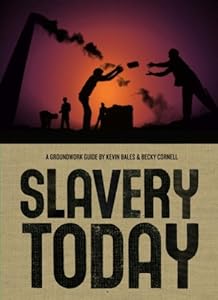 Cover of Slavery Today (Groundwork Guides)By Mark Curnutte • mcurnutte@enquirer.com • October 7, 2010
Cover of Slavery Today (Groundwork Guides)By Mark Curnutte • mcurnutte@enquirer.com • October 7, 2010 A story as complex and enormous as contemporary slavery might best be told through individuals.
That approach is the one the National Underground Railroad Freedom Center takes with its newest permanent exhibit, "Invisible: Slavery Today," which opens Saturday.
As many as 12 to 17 million people worldwide are forced to work against their will.
The set for the exhibit is a makeshift warehouse - designed as a dark place stumbled into by an unsuspecting public.
• Photos: Slavery exhibit
"What we hope to do, at very least, is raise awareness that this exists," said Paul Bernish, the Freedom Center executive in charge of its contemporary slavery exhibit and programs, believed to be the first such position in the American museum field. "Secondly, we want to offer people things they can do to become engaging to ending these forms of slavery."
The education comes first.
The realms of labor, child labor, sex trafficking, domestic servitude and bonded labor - work demanded as repayment of a loan - are humanized by real-life stories that greet visitors to the exhibit warehouse and represented by crude statues.
The soundtrack is staccato, looping sharply punctuated street sounds, factory machines and whistles and grinding chains.
The victims include:
Tatyana, who hoped to escape poverty in Moldova by answering a newspaper ad for work in a Milan nightclub. Instead, she is repeatedly raped, drugged and tortured. She is one of the estimated 2.5 million people caught in the international sex trade. Her likeness in the exhibit is that of dismantled mannequin limbs trapped in the folded metal frame of a single rollaway bed.
Mariano, 33, is a Guatemalan who left crippling poverty for the promise of work picking tomatoes in Florida, which he does 14 hours a day while living in squalor and fears being exposed as an illegal immigrant. His image is built from a series of tomato cans commonly found in groceries.
Helia, a five-year-old Haitian girl, was sold or simply given away by her parents for the promise of an education. In reality, she is denied the chance to go to school in favor of ceaseless domestic servitude, the limbs of her likeness represented by mops and brooms and draped in a work smock.
Freedom Center copywriters and editors and outside designers limited the amount of text in the exhibit and increased the visuals by incorporating documentary video footage and startling depictions of bare mattresses, crude tools and tattered clothing.
The Freedom Center, buoyed by positive early response by Haitian and Indian visitors who'd seen the incomplete exhibit, plans to create a traveling contemporary slavery show.
"We hope to ignite a spark in people that will move them to become activists and act upon what they believe freedom to be," museum curator Dina Bailey said.
The second gallery of "Invisible" offers information and details efforts already underway by anti-slavery groups that it worked with to create the exhibit, such as International Justice Mission, Free the Slaves, Polaris Project and GoodWeave. National media, including the New York Times and ABC News, have already visited Cincinnati to report stories on the exhibit.
The Freedom Center has continued to sharpen its focus and find an increasingly strong voice with exhibits examining lynching and domestic terrorism.
The creative staff thinks it has come upon a defining statement with "Invisible."
"We feel really good about it," Bernish said.
Expectations have been almost unrealistically high for the six-year-old museum.
Degraded by some as an "African-American" institution, bogged down by exaggerated attendance projections that billed it as Cincinnati's economic savior, and clearly appreciated more nationally and internationally than in its hometown, the Freedom Center wants to answer criticism that it is irrelevant in content and time.
Slavery remains a scourge. Many would rather pretend it didn't exist. " Invisible" is designed to keep slavery visible and connect its contemporary applications to its root in America.
Soft music with an introspective flute line drifts from the ceiling in the second "Invisible" gallery, dedicated to change and challenging action. On a wall is printed this passage:
"We are living in the midst of a tragic paradox; no longer is there an underground network to guide slaves to freedom but rather there is an underground criminal network to entrap them and sell them into slavery.
"Until we unite to confront this grave human rights violation, it will continue to plague the world and feed off vulnerable men, women and children."
Exhibit examines modern-day slavery | cincinnati.com | Cincinnati.Com
Source: Cincinnati.com


No comments:
Post a Comment